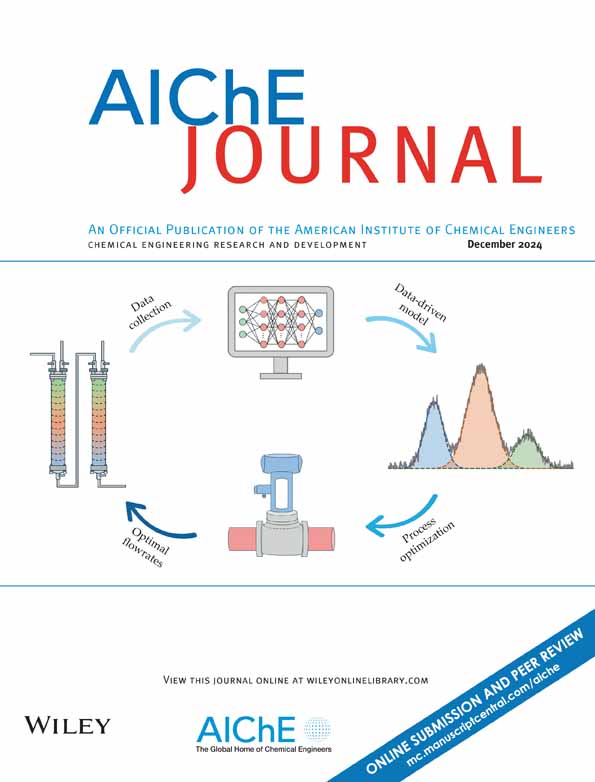Synergy of Ru single atoms and nanoparticles on Br-tethered covalent organic framework boosting reductive amination
IF 3.5
3区 工程技术
Q2 ENGINEERING, CHEMICAL
引用次数: 0
Abstract
Maximizing the atom efficiency of noble metal species is crucial for their application, but directly reducing the size down to single atoms (SAs) is limited when facing complex situations requiring the simultaneous adsorption and activation of multiple reactants. Herein, Schiff base condensation of 1,3,5-tris(4-aminophenyl)benzene and 2,5-dibromoterephthalaldehyde offered a Br-tethered covalent organic framework (COF) TAPB-DBDH for the co-loading of ruthenium (Ru) SAs and nanoparticles (NPs). We demonstrated a triadic synergism of Ru SAs (Ru–C3N1), Ru NPs, and the TAPB-DBDH framework in reductive aminations of carbonyl compounds with ammonia and hydrogen to primary amines, showing the high yield, large turnover number, and turnover frequency, stable recycling, and broad substrate compatibility. A systematic theoretic and experimental study revealed that the cooperation of Ru SAs and the TAPB-DBDH framework provided a strong affinity toward the carbonyl compound and imine intermediate to promote their conversion, while the co-existed Ru NPs lowered the energy barrier of H2 cleavage.钌单原子和纳米粒子在br系链共价有机骨架上的协同作用促进还原胺化
最大限度地提高贵金属的原子效率对于它们的应用至关重要,但是当面临需要同时吸附和激活多种反应物的复杂情况时,直接将尺寸减小到单原子(SAs)是有限的。本文通过1,3,5-三(4-氨基苯基)苯和2,5-二溴对苯二甲酸的席夫碱缩合,得到了一种br系链共价有机框架(COF) TAPB-DBDH,用于共负载钌(Ru) sa和纳米颗粒(NPs)。我们证明了Ru SAs (Ru - c3n1)、Ru NPs和TAPB-DBDH框架在羰基化合物与氨和氢的还原胺化反应中具有三元协同作用,表现出高收率、高周转率、高周转率、稳定的循环利用和广泛的底物相容性。系统的理论和实验研究表明,Ru NPs与TAPB-DBDH框架的协同作用对羰基化合物和亚胺中间体具有较强的亲和力,促进了它们的转化,而共存的Ru NPs降低了H2裂解的能垒。
本文章由计算机程序翻译,如有差异,请以英文原文为准。
求助全文
约1分钟内获得全文
求助全文
来源期刊

AIChE Journal
工程技术-工程:化工
CiteScore
7.10
自引率
10.80%
发文量
411
审稿时长
3.6 months
期刊介绍:
The AIChE Journal is the premier research monthly in chemical engineering and related fields. This peer-reviewed and broad-based journal reports on the most important and latest technological advances in core areas of chemical engineering as well as in other relevant engineering disciplines. To keep abreast with the progressive outlook of the profession, the Journal has been expanding the scope of its editorial contents to include such fast developing areas as biotechnology, electrochemical engineering, and environmental engineering.
The AIChE Journal is indeed the global communications vehicle for the world-renowned researchers to exchange top-notch research findings with one another. Subscribing to the AIChE Journal is like having immediate access to nine topical journals in the field.
Articles are categorized according to the following topical areas:
Biomolecular Engineering, Bioengineering, Biochemicals, Biofuels, and Food
Inorganic Materials: Synthesis and Processing
Particle Technology and Fluidization
Process Systems Engineering
Reaction Engineering, Kinetics and Catalysis
Separations: Materials, Devices and Processes
Soft Materials: Synthesis, Processing and Products
Thermodynamics and Molecular-Scale Phenomena
Transport Phenomena and Fluid Mechanics.
 求助内容:
求助内容: 应助结果提醒方式:
应助结果提醒方式:


